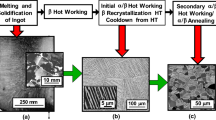Abstract
The behavior of contacting bodies under the thermomechanical loading in the conditions of low-cycle fatigue was analyzed within the developed mesomechanical framework, and the nature of formation of the tribodestruction centers in the near-surface metal layer is examined. It is shown that the further development of cracks is obtained between the braking cycles as a result of heating and cooling of the surface layer and formation of the temperature gradient, when thermal stresses under the surface layer reach the highest values. These stresses become proportional to the flash point temperature and cause strong heating in the thin layers of the friction surface, leading to the formation of burns, thermal spots (“bird’s eye”) and foci of microcracks, while the microscopically observed relief determines the region of quantum fatigue. At first, these centers of microcracks develop along normal to the side of the friction surface, and, then, according to the bifurcation diagram of metal fatigue, the bifurcation region expands in the direction of surface tangent of friction during transitions from macro- to meso- and nanoscale fracture level. Based on the development of fundamental concepts of physical mesomechanics, a discussion was held of the mechanism of self-organized formation at various scale levels of microstructures, which can be used in the developed complex tribological processes.



Similar content being viewed by others
REFERENCES
Chichinadze, A.V. and Braun, E.D., et al., Osnovy tribologii (trenie, iznos, smazka) (Fundamentals of Tribology: Friction, Wear, Lubrication), Moscow: Mashinostroenie, 2001.
Kragelskii, I.V., Trenie i iznos (Friction and Wear), Moscow: Mashinostroenie, 1968.
Goryacheva, I.G., Mekhanika friktsionnogo vzaimodeistviya (Mechanics of Frictional Interaction), Moscow: Nauka, 2001.
Panin, V.E., Lihachev, V.A., and Grinyaev, Y.V., Strukturnye urovni deformatsii tverdykh tel (Structural Levels of Deformation of Solids), Novosibirsk: Nauka, 1985.
Panin, V.E., Synergetic principles of physical mesomechanics, Fiz. Mezomekh., 2000, vol. 3, no. 6, pp. 5–36.
Chichinadze, A.V., Matveevskii, R.M., and Braun, E.D., Materialy v tribotekhnike nestatsionarnykh protsessov (Materials in Tribotechnics of Non-Stationary Processes), Moscow: Nauka, 1986.
Janahmadov, A.Kh., Fiziko-stokhasticheskoe tribomodelirovanie (Physical and Stochastic Tribo Modeling), Baku: ELM, 1988.
Janahmadov, A.Kh., Pirverdiev, E.S., and Volchenko, A.I., et al., Uzly treniya v mashinostroenii (Friction Units in Mechanical Engineering), Baku: EL, 2018.
Shanyavskii, A.A., Self-organization of nanostructures in metals under ultrahigh cycle fatigue, Fiz. Mezomekh., 2012, vol. 15, no. 5, pp. 91–105.
Janahmadov, A.Kh. and Nasirova, M.M., Mesomechanics of metal-polymeric pairs in friction units under low-cycle fatigue, J. Frict. Wear, 2021, vol. 42, no. 3, pp. 170–177.
Sakai, T., Li, W., Lian, B., and Oguma, N., Review and new analysis on fatigue crack initiation mechanisms of interior inclusion induced fracture of high strength steels in very high cycle regime, in Very High Cycle Fatigue, Proceedings of the 5th International Conference VHCF-5, June 28–30, 2011, Berlin, Germany, Berger C. and Christ, H.-J., Eds., 2011, pp. 19–26.
Mughrabi, H., On multi-stage fatigue life diagrams and the referant life-controlling mechanisms in ultrahigh-cycle fatigue, Fatigue Fract. Engng Mater. Struct., 2002, vol. 25, pp. 755–764.
Shiozowa, K., Morii, Y., Nishino, S., and Lu, L., Subsurface crack inivation and propagation mechanism in high strength steel in a very high cycle fatigue regime, Int. J. Fatigue, 2006, vol. 28, no. 11, pp. 1521–1532.
Janahmadov, A.Kh., Heat failure of friction pairs (brakes) operating in repeated – short regime, Frict. Wear, 1996, vol. 17, no. 4, pp. 470–474.
Ivanova, V.S., The concept of cyclic fracture toughness, in Tsiklicheskaya vyazkost’ razrusheniya metallov i splavov (Cyclic Fracture Toughness of Metals and Alloys), Moscow, 1981, pp. 5–19.
Janahmadov, A.Kh., Tribological properties at contact interaction of nanostructure coatings, Frict. Wear, 2020, vol. 41, no. 1, pp. 63–71.
Zhurkov, S.N. and Narzullaev, B.N., Time dependence of the strength of solids, Zh. Tekh. Fiz., 1953, vol. 23, no. 10, pp. 1677–1690.
Panin, V.E. and Egorushkin, V.E., Nonequilibrium thermodynamics of a deformed solid as a multilevel system. Corpuscular-wave dualism of plastic shear, Fiz. Mezomekh., 2008, vol. 11, no. 2, pp. 9–30.
Author information
Authors and Affiliations
Corresponding author
Ethics declarations
The author declares that he has no conflicts of interest.
Additional information
Translated by E. Oborin
About this article
Cite this article
Janahmadov, A.K. Mesomechanics of the Frictional Contact in Low-Cycle Fatigue Conditions. J. Frict. Wear 43, 203–208 (2022). https://doi.org/10.3103/S1068366622030059
Received:
Revised:
Accepted:
Published:
Issue Date:
DOI: https://doi.org/10.3103/S1068366622030059




